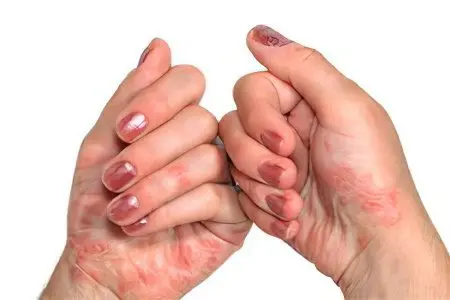Contents

Weeping eczema is a dermatological disease that develops against the background of impaired immunity and neuroendocrine regulation of the body. Its main manifestations are the presence of skin rashes in the form of vesicles (vesicles) with serous contents. Weeping eczema passes in an acute form, affects the hands and feet, but in severe cases of the disease with relapses, it can capture other areas of the body.
During weeping eczema, there are stages of erythema (redness and swelling of the skin), a vesicular stage, weeping and crusting. At the vesiculopapular stage, rashes form on the skin – papules with serous fluid, which, as the disease progresses, can either dry out or burst with an outpouring of exudate, the formation of serous wells. In this case, point erosions are formed, a weeping surface, which is accompanied by itching and discomfort and creates a risk of infection. As it heals, the stage of weeping turns into a cortical stage – crusts form at the site of skin damage, the skin around them becomes dry and covered with scales, peeling off.
The disease is characterized by periods of remission and exacerbation, the transition to a chronic form, in which the skin is thickened, acquire a bluish-red tint. It is impossible to get infected with eczema through household contact, since this disease is associated with internal disorders of the body, as a result of which the immune system gives an inadequate response to harmless chemical, physical and other irritating factors.
Treatment of eczema should be comprehensive. The effectiveness of treatment largely depends on the patient himself, who must make changes in his usual lifestyle, follow a special diet and avoid contact with irritants.
Causes of weeping eczema
Weeping eczema is classified as true or idiopathic eczema, the cause of which is immunity disorders, immune deficiency, neurological and endocrine pathologies. Women suffer from eczema more often, which is associated with constant hormonal changes in their body; weeping eczema affects mainly people from 20 to 50 years old.
Eczema is a polyetiological disease, so it is impossible to name one specific reason for its development. However, the occurrence of weeping eczema on the hands and feet can contribute to a hereditary predisposition to atopic diseases, endocrine system disorders and concomitant pathologies – diabetes mellitus, thyroid dysfunction, diseases of the digestive system.
The mechanism of development of eczema begins with a pathological immune response to external stimuli, as a result of which the immune system attacks the skin, causing disturbances in the processes of keratinization, growth of the deep layers of the epidermis and the release of the liquid blood fraction into the intercellular space.
The state of the immune system of patients with eczema differs from the norm – the number of B-lymphocytes is increased, while the number of T-lymphocytes decreases. This leads to a weakening of the body’s defenses, which makes it less resistant to infection. Thus, untimely or improper treatment of eczema can lead to aggravation of other diseases, and weeping lesions on the skin increase the risk of infection.
Psycho-emotional stress, post-traumatic stress, neuroses and overwork can provoke exacerbations of weeping eczema, since eczema is a neuro-allergic disease. Accordingly, a measured and calm regimen helps to reduce the severity of the negative symptoms of the disease and cure it faster.
Weeping eczema on the hands and feet is of four types:
True eczema – difficult to treat, characterized by acute spontaneous outbreaks that quickly become chronic. It begins with painful swelling and erythrema, after which the skin becomes covered with vesicular rashes. If the integrity of the bubbles is violated, weeping erosions occur, which subsequently become covered with crusts.
seborrheic eczema – it is provoked by disturbances in the activity of the sebaceous glands, which are located in large numbers on the hairy areas of the body, where rashes are localized. Seborrheic eczema can affect the shoulder blades, the skin behind the ears, and the chest area.
Microbial eczema – develops in the area of long-term non-healing wounds, traumatic skin lesions when they are infected with pathogenic microorganisms. Eczematous rashes affect the edge of the wound surface on one side and gradually grow.
Occupational eczema – develops in cleaners, workers in chemical and other industrial enterprises, builders and other persons who, by virtue of their profession, often come into contact with chemical and physical irritants. A distinctive feature of this type of eczema is localization on the skin of the hands, on which irritating factors have a direct effect.
Weeping eczema symptoms

Weeping eczema is characterized by evolutionary polymorphism of the course, that is, in one area of the skin, you can see all the stages of the manifestation of the disease – vesicles, point erosion, a weeping surface, crusts and peeling.
When the inflammatory process subsides, the disease becomes chronic – new rashes do not appear, but the skin darkens, thickens, over time, age spots appear at the site of the lesions, which spontaneously disappear.
All eczematous rashes are localized in typical places – legs and arms, in some cases – the face and neck. By the location of the spots and rash, one can judge the type of eczema. So, professional eczema affects the skin of the hands and is the result of frequent contact with chemicals or physical irritants. If most of the rashes are localized on the feet and palms, then most likely they are provoked by dyshidrotic eczema.
Weeping eczema should be differentiated from pustular skin lesions, which are characterized by the formation of a continuous weeping surface. With eczema, the lesions are punctate with droplets of exudate that look like dew.
Weeping eczema treatment
Therapeutic measures in the treatment of eczema on the hands and feet include the use of topical agents and systemic drugs. Due to the neurological component of the disease, eczema therapy is not complete without sedatives, among which preparations based on plant materials are mainly used. Of paramount importance for the correction of neurological disorders is the normalization of sleep and rest.
Among systemic drugs, in addition to sedatives, antihistamines are used, which allow you to remove the negative manifestations of eczema caused by an allergic reaction – itching, swelling, rashes.
Therapeutic measures are aimed at desensitizing the body, include the use of enterosorbents that absorb toxins and promote their elimination.
In addition, patients during an exacerbation of weeping eczema are advised to eat only neutral foods that do not provoke allergic reactions. Oranges, lemons and other citrus fruits, chocolate, red berries and fruits, honey and other potential allergens are removed from the menu (more on the eczema diet).
[Video] Dr. Evdokimenko – Psoriasis, ECZEMA, diathesis, DERMATITIS, colds and VIRUSES = 1 simple treatment:
Prevention of weeping eczema
For topical application, lotions with ointment based on sulfur and petroleum jelly, ichthyol or birch tar are recommended.
Wear comfortable shoes that do not squeeze the feet, impeding blood circulation; socks made of hypoallergenic natural materials that do not provoke an exacerbation of eczematous rashes;
Follow the general recommendations for patients with eczema regarding diet and a moderate lifestyle, avoid stress, overheating and unnecessary stress on the nervous system, observe sleep patterns.
General recommendations for patients with eczema

Contact with water as little as possible, preventing the affected skin from getting wet; limit water procedures to exclusively hygienic purposes. Avoid going to the sauna and bath, where contact with water is combined with overheating of the body, both of these factors are triggers of the disease.
Follow a diet for patients with dermatological diseases, exclude already known and potential allergens from the diet. Avoid situations in which infection with pathogenic microorganisms, viruses, in particular, the herpes virus, is possible. Timely treatment of dysbacteriosis and infectious diseases, giardiasis, pyoderma and parasitic infestations with pinworms and roundworms.
If eczema is complicated by an associated infection, the pathological process worsens, treatment is delayed and rarely does without antibiotics.
Prednisolone and other corticosteroids are often used among systemic hormonal agents for the treatment of weeping eczema, but they cannot be used for long courses.
After the transition of the disease to a chronic form and a decrease in inflammatory processes, one can proceed to physiotherapeutic measures – cryotherapy, laser therapy, magnetic therapy, etc.









